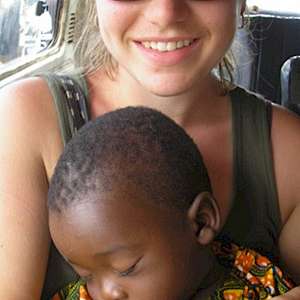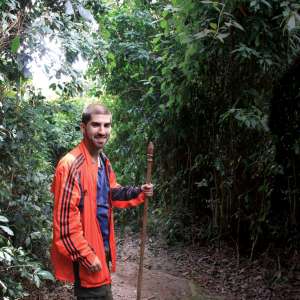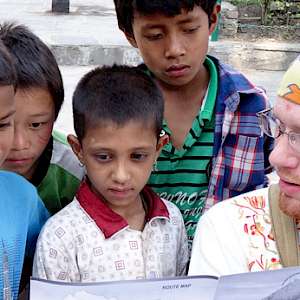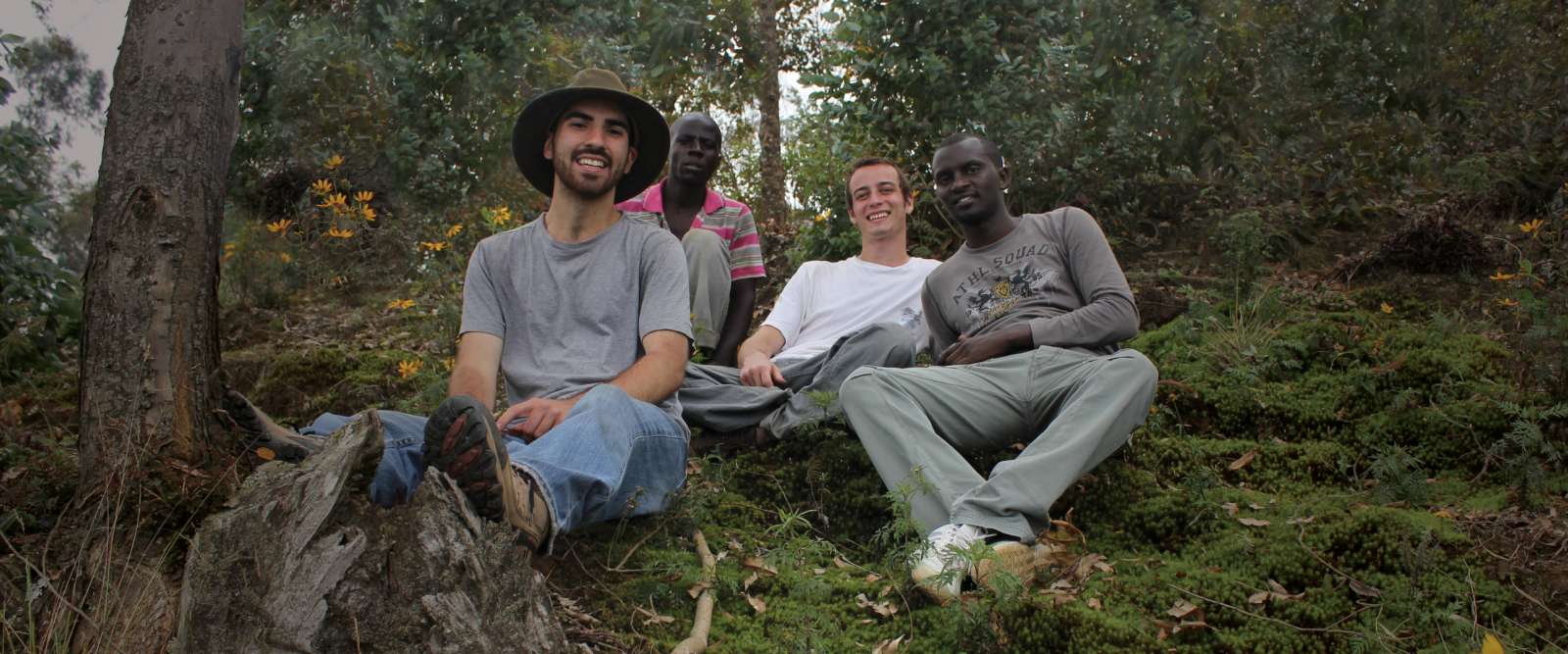
Fall 2014: The World
In ways big and small, the Keene State community is changing the world by experiencing it first-hand. This issue of Keene State Today is dedicated to international engagement on the part of alumni, faculty, and students – be it through study or service abroad, living and working in other countries, or conducting research in far flung places.
Features



Online Extras
Keep in Touch, Oui?
Aux diplômées et aux diplômés de Keene State! J’ai l’honneur et le plaisir de vous adresser la parole en français tout en vous invitant à vous remettre en contact avec l’Association des Anciennes et des Anciens de Keene State email alumni@keene.edu and/or update your information online. Je vous prie de nous raconter l’histoire des effets bienfaisants qu’a eus le français dans votre vie ou bien personnelle ou bien professionnelle et de partager avec nous vos plus beaux souvenirs des études que vous avez faites à l’étranger. Je me réjouis de pouvoir me remettre moi-même en contact avec vous et je vous souhaite le plus grand bonheur possible.
Toutes mes amitiés – Thomas
Dr. Thomas Durnford
‘Connections Are What I Made’
Music teacher Dayna Lee Drake-Walker ’73 provided this account of the travels and research she undertook through two Fulbright fellowships she’s received.
Senator J. William Fulbright said that the Fulbright program “aims to bring a little more knowledge, a little more reason, and a little more compassion into world affairs and thereby to increase the chance that nations will learn at last to live in peace and friendship.”
“Kia ora and Sainbainuu!” (That’s “Hello!” in Māori and Mongolian, respectively.)
Ever wonder what Temüjin (Genghis Khan) and his descendants and the Polynesian ancestors of the Māori were doing in the 13th century? Ever wonder why the Fulbright program and the US Department of Education combined New Zealand and Mongolia in one seminar? Dayna Drake did, so she applied for and received a Fulbright-Hays grant to find out.
Dayna Lee Drake-Walker ’73 traveled to Hawai’i, New Zealand, Beijing, China, and Mongolia through the Fulbright-Hays Seminar Abroad program sponsored by Fulbright, the US Department of Education, Fulbright New Zealand, the American Center for Mongolian Studies at the National University of Mongolia and the Mongolian Education Alliance.
The program focus, “A Day in the Life of: Exploring the Origins of Communities,” allowed her to study and research culture, communities, and education systems in both developed and developing countries. School visits, teaching opportunities, community service projects and living with a host family were among the many highlights of the trip.
She based her fourth-grade integrated comparative social studies and music curriculum project on her experiences and wrote for Chase Collegiate School and the sponsoring organizations. Part of her project involving student work was presented at the annual meeting of the American Center for Mongolian Studies in Philadelphia.
The Philadelphia presentation and Fulbright-Hays trip were the very first elementary-level ventures for the American Center for Mongolian Studies, which also sponsors post-graduate scholarly research by universities, the Luce Foundation and the Fulbright program. Fulbright expects its scholars to give back to the community; the ACMS annual meeting, in conjunction with the Association for Asian Studies Conference, was one opportunity.
Other giving back opportunities included sending care packages and children’s books to a Chase alumna and her family and to host schools in Christchurch, New Zealand, after devastating earthquakes. English books, music and children’s games were a few of the gifts sent to new friends, her host family and schools in Ulaanbaatar, the Gobi and on the central steppes of Mongolia. Eager students wanting to better their English and learn more about the United States wrote thank you letters in both English and Mongolian, promising to visit when they were older.
Dayna’s Keene State education helped make her life easier in Mongolia. “ESL training and children’s literature classes taken at the College years and years ago were recalled and very helpful. I was asked the English names of Mongolian animals by a bus driver who spoke only Mongolian and Russian. I colored superhero pictures with a six-year-old boy and danced the Hokey Pokey at a summer camp for orphaned children. I played recorders, sang, reviewed music theory, and shared music of favorite performers with Mongolian jazz musicians. Camaraderie, music, and humor were universal. So were prayers offered by Buddhist monks for our safe passage. I was a novelty to a few folks with my gray hair and green eyes. I was known as ‘Auntie’ or ‘American Mom’ to others. Gestures of respect, courtesy, and kindness were present throughout my visit. During one particular bus ride into the countryside, a stranger offered his deel – traditional outerwear – for me to wear because I was cold. Others were proud to offer hospitality and share traditions. Our group went ‘guesting’ in towns and to nomadic herders’ gers – homes – in the countryside. I was treated as an equal and offered food, drink – tea, fermented mare’s milk, fresh camel’s milk, vodka – and the male head of household’s snuff bottle. And everywhere, Chinggis Khaan – Genghis Khan – was present. My hosts were pleased that I had read The Secret History of the Mongols,” she said.
The Fulbright New Zealand buddy program linking alumni and current scholars teamed Dayna and her students with a visiting professor from Canterbury University who was studying emotional intelligence at Yale. She shared Māori songs, dances, and stories with Dayna’s students, bringing a faraway place closer to home.
“The bonds that were formed and the incredible generosity by host families and institutions during my journey impacted my life more than I ever expected, and it was a pleasure and privilege to be able to give back in different ways,” she said.
Dayna’s first Fulbright-Hays Seminar Abroad was to Australia, and had a focus on “New Country, Old History.” The Australian seminar allowed participants to fully engage in Australian culture, exploring the history, geography, struggles, successes, and lifestyles in various parts of the continent.
“I have a better understanding of the culture and history in the places we visited. The oral traditions, song lines of the Dreamtime, and the respect for the land are aboriginal culture. The land is the heart of everything, the reason for existing; still, some disrespect it and the people who are stewards of it,” she said. “I learned what instruments are played, and the traditions. For example, the didgeridoo is an instrument that aboriginal women aren’t allowed to play. Out of respect, I didn’t perform on it, but I wanted to learn how to play it to share the instrument fully with my students. There are still some separate rituals for men and women.”
Her research project was awarded a high commendation from the Australian-American Fulbright Commission.
Following her Fulbright trips, Dayna was awarded a Chase Faculty Fellowship by her school and traveled to Iceland and Greenland. She learned about similarities between Iceland and New Zealand and shared Mongol and Inuit heritage in Greenland.
“Two particularly humbling experiences were standing near the separation between the North American and European plates in Iceland and touching icebergs in Greenland. I felt insignificant by those forces of nature, yet spiritual and empowered at the same time,” she said.
Of her two Fulbright experiences, Dayna said, “Both were life-changing. I have a greater respect and deeper understanding of the places and people I had only read about in books. I wanted to be a part of a program that promoted understanding and empathy through knowledge. I wanted to be a more informed, more enlightened person to help my students better understand the world in which they live now and the changing world in which they will live. An opportunity to broaden my own exposure to other cultures, to find similarities, to meet new people and learn from them, to exchange ideas, to learn experientially, and to share whatever resources I have with new friends was and is still an enriching, inspiring challenge. Students and teachers constantly learn from each other, and I owed it to my students to better myself and my teaching and to continue to grow. Connections are what I made, connections are what I have, and connections are what I will keep. My two Kids’ Connections curriculum projects were dedicated to my students to help further their connections. I believe in the world of my students. There is so much for all of us to discover. Fulbright and Chase believed in me and gave me opportunities, and I will be forever grateful.”
And in case you were wondering what was happening in New Zealand and Mongolia in the thirteenth century… a place called Aotearoa, “land of the long white cloud,” was being settled, and a man called Chinggis Khaan (Чингис Хан) was increasing the size of his empire and uniting nomadic tribes under “the eternal blue sky”!
A Responsibility to Work for Justice
George F. Roberson ’86 is the founder, publisher, and director of Collaborative Media International, a nongovernmental organization dedicated to “furthering intercultural dialogue and understanding between the USA, the North Africa / Middle East Regions, and world-wide through multinational collaboration, research, and education.” He divides his time among Denver, Amherst, Massachusetts, Tangier, and Mexico City.
KSC launched me into the world. Although I hold a PhD in geosciences, liberal arts is the toolbox with which I work and engage in the world. No single thing impacted me more during my KSC years than Dr. Al Rydant’s lecture on the apartheid system in South Africa. I took from it a responsibility to try to do things in my life that might help reduce injustice.
In the 1990s I became interested in processes of change and in Muslim-majority countries and began traveling – to places like Bosnia, Lebanon, Syria, the occupied West Bank, Western Sahara, and Indonesia. I observed that force is neither a constructive nor a lasting strategy. I learned how little I knew about these headline-grabbing places. I learned that what I “knew” was incomplete and often wrong.
So I returned to school and, after September 11, 2001, determined to learn as much as I could about the Middle East and North Africa. I focused my research on Tangier, Morocco. At the cusp of lands, seas and cultures, Tangier has been successfully negotiating what’s been called the “contact zone” since the arrival of Phoenician traders 2,500 years ago.
By 2006, with force-centered strategies failing in Iraq and Afghanistan, I turned my efforts to putting alternative theories into practice. With a Fulbright research grant I worked for a year in Morocco with Dr. Khalid Amine of Université Abdelmalek Essaadi. We’ve established two NGOs dedicated to constructive, collaborative international engagement: International Centre for Performance Studies, based in Morocco, and Collaborative Media International (CMI), based in the US. We host an annual international conference and publish educational materials, Arabic to English translations, and volumes of literary criticism and debate. CMI’s first film, Joshua Tree, takes up the impacts of the 2008 US economic collapse.
Putting knowledge to use to create constructive theories, and then putting those theories into practice – to me, this is what academics do. CMI is an example of this; our hope is that it will prove a more successful and lasting approach to international engagement than the use of force.
– George F. Roberson ’86 Learn more about CMI.
‘Exhausting and Exhilarating’
When Professors Jo Beth Mullens and Pru Cuper answered a call to adventure, they brought along cadre of Keene State students. The call was to teach a global engagement course for the College’s Morris-August Honors Program, which involved a classroom component and a two-and-a-half week trip to Peru.
That trip and another, to Belize, convinced the two of the value of international programs led by faculty. But their experiences also pointed up the dearth of information available for college and university professors undertaking international travel with students. The two put together the know-how they’d developed over the course of their teaching careers with the strategies they’d learned on their trips and wrote a book: Fostering Global Citizenship Through Faculty-Led International Programs. The idea was to create a manual for other academics that part nuts and bolts and part inspirational.
Two excerpts follow:
On teaching and learning:
“The international teaching arena, which can be both challenging and unpredictable to even the most seasoned instructors, offers a number of ways to improve and more fully enjoy your professional craft. Four ways readily come to mind. First, you will have the opportunity to teach in a dynamic, international ‘classroom.’ Second, you will develop new teaching pedagogy – by necessity. Third, whether you want to or not, you will be a co-learner with your students. And fourth, you will be ‘on the ground’ with your students, enjoying the excitement of their learning on a more personal level.
On embracing challenges:
“On the third day of our field course to Peru, we awoke to the sound of people shouting and gathering in the streets of Urubamba. From our window, we could see men and women beginning to pile rocks and roll boulders onto the main road. At breakfast, we learned that a regional strike had been called for and that it would last the next few days and possibly repeat the following week. We also learned that the strikers were protesting attempts by the government to privatize water within the communities in the area. This meant that local farming communities would be required to pay for a vital resource that had always been free. In protest, shops were to be closed and all transportation, public and private, to be stopped as local citizens were asked to voice their objection by marching in the streets.
“From our perspective, this could not have come at a worse time. We had just arrived in Peru with our students to undertake a 17-day field course that involved service-learning in communities surrounding Urubamba. The culmination of the course was a trip to Machu Picchu. The strike, which immobilized all transportation in the area, would create a real problem for us in completing our service projects and could even threaten our promised trip to the famous Incan city. In our pre-trip campus meetings, we had prepared our students for a well-thought-out and detailed itinerary. This itinerary did not include a strike. While as co-leaders we vented our frustration together, we also realized we would have to make the best of the situation, regroup, and adjust our plans.
“After calming ourselves down, we began to appreciate that a course in global engagement could, in fact, include some true global engagement – of the unplanned variety. We called our students together and told them with seeming enthusiasm that, while our plans to visit Machu Picchu might be interrupted, we were experiencing a possible once-in-a-lifetime opportunity to observe and interview our Peruvian hosts as they engaged in an act of economic and political solidarity. Our students, too, had observed the strike that surrounded us. Some were fearful; others appeared invigorated by the event. With input from the service provider who had helped plan our trip (a mix of Peruvian and American guides), the students took to the streets to interview a wide range of participants. Working in pairs, some would talk with young people, others with women and shopkeepers, still others with city officials. Together, we came up with questions to ask that would lead to productive conversations and register the multiple perspectives on the strike.
“When we brought our group back together to share what they had learned, we realized that this unanticipated event may have been the most valuable experiential learning opportunity of the entire course – for the students and for ourselves. The students were truly able to connect with the needs and priorities of people from a culture different from their own. They saw collective action and questioned how a similar situation might have occurred or even been allowed to occur in the United States. Our students wondered if our country would countenance an act of civil ‘disobedience’ such as this strike that was crippling transportation across the entire country for days. They began to more fully question the concept of democracy in their country and in Peru, and whether, in fact, their country truly supports democratic actions that directly challenge established power structures and institutions.”
A Month in the Land of the Thousand Hills
Alexander Habibi ’15 – who is pursuing two bachelor’s degrees, one in European history and one in Holocaust and genocide studies – traveled to Rwanda this summer with a group of Keene State stu0dents and Professor Therese Seibert. He spoke by phone with Keene State Today about the experience.
KST: Would you give a brief overview of the trip, please?
The first two weeks we spent traveling around the country, mainly, just going to all the sites and visiting various memorials. We didn’t stay anywhere for too long, except for Butare, the second biggest city in the south. We spent the last two weeks at the Peace-Building Institute facilitated by Never Again Rwanda. The first part of the trip was traveling and getting to know the country, and the second part was the learning and the heavy stuff.
KST: Did you have the opportunity to interact with Rwandan people?
You have to when you travel. Just getting directions, you have to overcome the issues of language, even though English was a lot more widespread than I thought it was going to be. You interact with a lot of locals. You have to basically eat like a local, so we had a lot of the local cuisine. We spent a lot of time driving, so we saw people going about their daily activities, and we saw how much of the country is involved in agriculture. About 80 percent of the country is involved in subsistence farming.
Rwanda means “Land of the Thousand Hills,” and there are probably 1,001. A lot of people picture central Africa as sprawling rain forest, but the forests were pretty well managed, so the land was terraced. We saw a lot of rice paddies, a lot of sorghum, maize, a lot of goat – goat is the biggest source of protein. You see cattle in some areas, and pigs in the north and the west. The country is the size of Vermont, but with about 10.5 to 11 million people. It’s also very geographically diverse.
KST: You’ve talked about the fact that South Africa and Rwanda took different paths in 1994, with one country descending into genocide and the other pulling itself out of generations of Apartheid.
It boils down to governance, really. There needs to be a political will to stop human rights abuses. Humans cause problems, so there have to be human solutions to them.
KST: Are those the kinds of issues addressed at the Peace Institute?
We talked a lot about not only the origins of conflict, but how they can be overcome and what civil society’s role is, what’s the state’s role is. There were six Rwandese students and nine American students, plus the Never Again staff and the facilitators. We had a lot of guest lecturers from various NGOs, and we took a lot of field trips to see what Rwanda is doing to overcome some of the issues that caused the genocide.
KST: You and another Keene State student, Kelly Christianson, gave a presentation.
We presented on [Keene State Professor of Holocaust and Genocide Studies] James Waller’s theory on perpetrator behavior, which he explains in his book Becoming Evil. It’s less about architects of genocide, the generals and politicians planning it; it’s more about how people become killers at the base level. We went over the cultural causes at the macro level, then we looked at psychological causes at the micro level, and then we looked at social influences, so it’s a very big, dense model. The Rwandese students responded to it well. They immediately applied it to what happened in their country. Then we came up with strategies on how some of these behaviors can be corrected or undone. The Rwandese students were really interested in a presentation by a psychologist from a German aid organization who also talked about perpetrator behavior. They wanted to know how such behavior could happen in their country.
KST: Do you feel like they are getting some answers on that?
I think so, but to a certain degree I think they’re at a point where they just want to move on. In colonial times and then in the post-colonial era there was this obsession with trying to figure out who were the original inhabitants of Rwanda, whether the Hutu or the Tutsi were there first, but now the youth, especially, say those divisions haven’t done much good, and they’re just focused on moving ahead. The government of Rwanda set a millennium development goal to become a middle-income country by 2020, which is ambitious, but they’re working really really hard, and it’s amazing. Kigali was the cleanest city I’ve ever been to in the world. It’s huge. It’s a massive city, and plastic bags are illegal, the streets are swept there. It was very well managed. People seemed to have a strong civic identity.
KST: What are your career plans?
After I returned from Rwanda, I spent the summer as an ESL tutor in Boston for the Haitian Multi-Service Center. When I graduate in December, I’m looking at teaching English overseas, probably in South Korea or China. My main goal is to keep doing service and to keep traveling and keep experiencing new cultures. The eventual goal is to take the Foreign Service officer exam and serve as a Foreign Service officer.
KST: What else would you like to mention about Rwanda?
I would just like to say that all of these observations and facts I’ve been recounting are based on my perceptions, and I was in the country for only a little bit more than a month. I’m not fluent in Kinyarwanda, or French, the two main languages spoken there. The culture is very hard for a white foreigner to penetrate. The Rwandese people are very reserved, and rightfully so with what’s happened. I think it’s important for people to understand that when they’re in a foreign culture, they’re not describing the objective facts. Their observations say more about their personal biases than what they’re actually seeing. I’d also like people to know that Rwanda is a very safe country and that there is infrastructure. I would recommend it to anyone who would like to travel there. I didn’t feel unsafe once.
I’d also like to thank Dr. Seibert for working really hard to bring us over there, and for all the support from Keene State for letting us travel to Rwanda. We came back safely, and no one got malaria!
Class Notes Extras
Marry Me?
Army Specialist Nicholas Greenwood ’13 got some help from his platoon in proposing to his beloved. Watch the story on WMUR.
An Engaging Moment
Chris Reynolds ’10 writes of his engagement to Jackie Vehlies ’10: “We want to share our engagement, which actually took place right next to Brickyard Pond by the Redfern Arts Center on Saturday, April 5. Jackie and I met in Pondside 1 our freshman year (2006) and started dating a few weeks later. We have been together ever since. For the proposal I asked the student organization Chock Full o’ Notes to be part of a flash mob serenade of our song, “Faithfully” by Journey. And they did so graciously and amazingly.” Watch the video.
